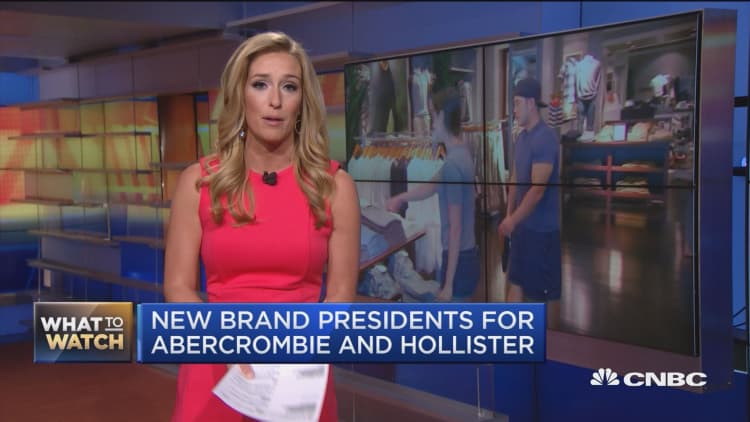Sick of spending $5 on a T-shirt, only to have it wither away by the time spring rolls around again? The team at Abercrombie & Fitch is betting that you are, and is reinventing the company's namesake label to meet that perceived need.
Executive Chairman Arthur Martinez told CNBC on Thursday "there's a theory" out there that shoppers are tiring of disposable fashion, and are willing to spend more for quality clothing that's built to last.
As such, the Abercrombie brand is shifting its sights from teens, as it attempts to become a more "sophisticated" label for 20-somethings with an "eye for style."
The change comes as consumers continue to clamp down on apparel spending, causing specialty clothing and department stores to struggle against fast-fashion, value and off-price chains.
"We are not playing the fast-fashion game with Abercrombie," Martinez said.
Though the brand's goal is to be associated more with luxury than back to school, the shift shouldn't drive its price tags much higher, Martinez said. Instead, the company will lean on better sourcing, a smarter supply chain and fewer promotions to profitably grow sales, and invest more value into its product. Like other apparel retailers, Abercrombie also has the benefit of cheap cotton prices.
The retailer has already been weaning customers off of discounts, thanks to a better assortment and leaner inventories. Though this pullback in promotions weighed on Abercrombie's top line during the first quarter, the company nonetheless turned more of its visitors into buyers, and was able to generate more profitable sales.
"It's all directed at brand health over time," Martinez said. "You have to be steadfast and hold the course on this kind of stuff even when the environment is not helpful."
Over the past few years, consumers' frugal spending habits and a desire for ever-changing styles plucked shoppers away from the traditional teen retailers, whose fashions were viewed as outdated, unstylish and too pricey. As Abercrombie and its competitors whittled down their store bases, H&M's footprint swelled to more than 4,000 locations globally.
But trends at H&M have slowed lately. Despite its rapid store expansion, the mega-retailer's sales grew just 9 percent in the first quarter, and trends got off to a shaky start in the current three-month period. The same headwinds that have dented revenues at other players in the apparel space — including a strong dollar, unfavorable weather and excess inventory — have contributed to the brand's softness.
Yet Martinez said recent results at H&M and Forever 21 add credibility to the theory that consumers are tiring of cheap fashion.
"The rocket ship that they both were on for a period of time now seems to have run out of fuel," he said.
Privately held Forever 21 doesn't publicly release its earnings, but the retailer has recently been closing stores. A spokesperson from the company wasn't immediately available.
Betty Chen, managing director of Mizuho Securities, said she too has noticed certain consumers' preference for quality product, better in-store service and pricier custom pieces. However, she said this has more been the case for shoppers in their late 20s and older.
Chen also cautioned that few brands have been able to reposition themselves as higher-end players. One of those brands was J.Crew, yet it, too, has struggled recently.
"It's going to be a very long road given the historical brand context for Abercrombie & Fitch," she said.

Abercrombie's turnaround hit a speed bump Thursday, when it reported a slowdown in comparable-sales trends from the prior quarter. During the first quarter, same-store sales at the Abercrombie brand fell 8 percent, while those at Hollister were flat. That performance came despite easy prior-year comparisons, when sales at those labels dropped 9 percent and 6 percent, respectively.
Slow foot traffic at the company's international stores, which accounts for more than a third of its revenue, and weakness at its tourist locations were the two big culprits behind its shortfall. Management said it expects traffic and comparable-sales trends to remain challenging in the second quarter, but expects to see improvement in the second half of the year.
At that time, product changes from its new design team will be in stores, and the majority of its Hollister shops currently closed for remodeling will be back up and running. Sales and traffic at the 24 recently remodeled Hollister stores, which are brighter and more open, have increased at a double-digit pace compared to the rest of the fleet, management said.
Still, Chen called Abercrombie's first-quarter performance "disappointing" given its recent improvement.
"Many of us in the investment community had thought [the fourth quarter] was a stabilizing or inflection point," she said.
That the company is not actively searching for a CEO — a role that has been vacant since Mike Jeffries' exit in 2014 — also gives Chen pause. And though many of its first-quarter struggles were tied to tourism and currency challenges (as opposed to problems with its product), she expects those issues to persist throughout 2016.
"That's a headwind that's going to be very difficult to battle throughout 2016," she said.







